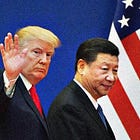The Administration’s Foolish War on Basic Science
Cutting funding for gravitational wave studies won’t save taxpayers much but will jeopardize future scientific breakthroughs
Gravitational waves are tiny ripples in the fabric of spacetime, generated when massive objects such as black holes and neutron stars collide. Their existence, theorized by Albert Einstein in 1916, was confirmed in 2015 when the Laser Interferometer Gravitational-Wave Observatory (LIGO), a pair of detectors in Washington state and Louisiana, picked up emanations from black holes that smashed into each other over a billion years ago (that’s how long it takes for the waves to travel to Earth). That marked the opening of a Nobel Prize–winning field in which the United States has unparalleled facilities and talent. There have been over 300 gravitational-wave detections in the past decade; in mid-July, the most massive black-hole collision to date was reported. In September, just as the field was celebrating the 10th anniversary of the first detection, new findings confirmed theorems Stephen Hawking long ago proposed about how black holes expand and what information the objects destroy or retain.
But the Trump administration’s fiscal 2026 budget proposal for the National Science Foundation (NSF) slashed the science agency’s budget by 56% from $9 billion to $3.9 billion. That included a 39.6% decrease in LIGO’s funding, from $48 million to $29 million, with instructions that only one of the two detectors continue to operate.
The cuts, expectedly, caused a great deal of consternation among scientists. But the Wizard of Oz–type glimpse of the administration’s limited grasp of the science programs over which it was wielding power should discomfit even the most ardent limited government, fiscally conservative budget cutter.
Shutting one detector wouldn’t be a savvy elimination of redundancy, but a crippling blow, as the detectors work in tandem. Each detector is an L-shaped set of concrete-encased metal vacuum tubes with arms 2.5 miles long, through which lasers travel, registering photons on sensors. Variations in the photon hits can indicate a gravitational wave; as such waves travel at the speed of light, the detectors, thousands of miles apart, receive them within 10 milliseconds of each other. A longer interval in receiving them or a solitary detection could indicate some terrestrial cause, such as an earthquake, rather than a gravitational wave. Aided by smaller facilities in Italy and Japan, LIGO operates with broad coverage of the sky. With one detector shut, the data would reduce to a trickle, discerning just 10 to 20% of the astronomical events that would be captured by two, as astronomer Lieke van Son has explained in Scientific American.
Fundamental Conflict
That there is a “war on science,” or something to that effect, has been a widespread observation in recent years, albeit with divergent views as to who is waging it and why. One book, titled after such a war, identifies corporations and religious extremists as central to the problem, while another of the exact same title depicts academic leftism as a threat to science. Until recently, though, such conflict was concentrated in areas where scientific findings carried policy implications, as with climate or vaccine research, or conflicted with a religious or ideological worldview, as with evolution. Often there has been some commercial interest at stake as when the tobacco industry launched its notorious campaign to create doubt about scientific evidence showing the link between smoking and lung cancer, emphysema, and other diseases. Or when fossil fuel interests questioned climate change science corroborating the anthropogenic component in global warming. Or, more recently, groups promoting their own ill-founded health products countering vaccine distribution.
But what’s odd about the current moment is the stepped-up political hostility to basic science (also called fundamental or “pure” science), aimed at uncovering secrets of nature, that has no immediate policy implication. Scientists engaged in puzzling out black holes or elementary particles may be surprised to find themselves also besieged by political hostility, but that’s what has happened. Such is a consequence, now breaking into public view, of a free-floating anti-intellectualism that has been building in right-wing circles, and which is reflected in the Trump administration’s emphasis on cutting science budgets and scientific advisory panels. Suspicion of federal bureaucracies, antipathy for universities, and a distrust of experts all feed into the mix.
So does xenophobia. American science has long thrived on the country’s openness to immigrants and visitors. An environment in which scientists from around the world are unable or fearful to come to the U.S. is not conducive to American leadership in science. Similarly, a lack of commitment by U.S. officials to participate in international science collaborations with foreign governments will damage U.S. science. Such problems may take the form of a zero-sum game, in which a U.S. brain drain benefits other nations that gain leadership in scientific fields. But there may also be negative-sum effects, where reductions in U.S. science spur no compensating effort elsewhere, and everyone loses.
Particle Politics
Much basic research is too large-scale and long-term for anyone but government to fund it. Philanthropy, even by billionaires, can’t handle vast, decades-long projects, as evidenced by the abandonment of Breakthrough Starshot, a private initiative to send out interstellar probes. Major tech companies fund basic research, but only when it looks likely to lead to applied research and commercial product development, as with semiconductors and superconductors. The question becomes: Why should government spend money on delving into cosmic mysteries, given other needs and priorities? But an assumption that understanding the universe for the sake of understanding it is a “luxury” forecloses future possibilities no one has yet contemplated.
In his 1995 book, The Demon-Haunted World, in a chapter titled, “Maxwell and the Nerds,” astronomer Carl Sagan proposed a fanciful thought experiment:
Suppose you are, by the Grace of God, Victoria, Queen of the United Kingdom of Great Britain and Ireland, and Defender of the Faith in the most prosperous and triumphant age of the British Empire. ... Suppose in the year 1860 you have a visionary idea, so daring it would have been rejected by Jules Verne’s publisher. You want a machine that will carry your voice, as well as moving pictures of the glory of the Empire, into every home in the kingdom. What’s more, the sounds and pictures must come not through conduits or wires, but somehow out of the air.
In Sagan’s scenario, the queen initiates a “Westminster Project,” amply backed by government funds and staffed with top scientists and engineers, to undertake this challenge. “But the Westminster Project would almost certainly fail,” Sagan wrote. “Why? Because the underlying science hadn’t been done.” Shifting from the counterfactual, he described the work of James Clerk Maxwell and other 19th-century physicists in uncovering the nature of electromagnetism, through research that followed idiosyncratic paths and (unlike in the fictional initiative) had no goal of developing the technologies posterity would know as radio and television.
Sagan was defending fundamental science at a time when public and political enthusiasm for it had started to fade, in part a consequence of the Cold War’s end having lessened the urgency of demonstrating national scientific and technological superiority. The Superconducting Super Collider, a huge accelerator for which tunnel construction in Texas had begun, was canceled by Congress in 1993. That move marked a change from decades earlier when physicists successfully sought federal support of particle physics (a term synonymous with high-energy physics, as many particles manifest at high energies).
On April 17, 1969, physicist Robert R. Wilson testified before the congressional Joint Committee on Atomic Energy about the prospect of federal funding of the first particle accelerator to be built at what would become the Fermi National Accelerator Laboratory, or Fermilab, in Illinois. Such a machine would enable huge advances in particle physics. Sen. John Pastore, a Rhode Island Democrat, opened by noting the existence of hunger and rat-infested housing, then segued into questioning the merit of spending $250 million on an “experimental machine, in fundamental high-energy physics, and we cannot be told exactly what we are trying to find out through that machine.” Wilson explained that the goal was to make sense of elementary particles and the forces of nature, and said that because of such research, people would “eventually be able to enjoy a richer life, in an intellectual and spiritual sense certainly, but also in their physical well-being.” When Pastore asked if the accelerator would contribute to national defense, Wilson said it would not. Pastore then asked whether there was “anything here that projects us in a position of being competitive with the Russians,” to which Wilson gave a much-noted reply:
Only from a long-range point of view, of a developing technology. Otherwise, it has to do with: Are we good painters, good sculptors, great poets? I mean all the things that we really venerate and honor in our country and are patriotic about. In that sense, this new knowledge has all to do with honor and country, but it has nothing to do directly with defending our country except to help make it worth defending.
Wilson’s argument succeeded (though he would quit as director of Fermilab in 1978 in protest of budget constraints). The accelerator was built, and high-energy physics proceeded, allowing physicists to develop the Standard Model, a richly detailed picture of nature at a fundamental level; it is, though, known to be incomplete, falling short of a unified account of gravity, electromagnetism, and other basic forces. This research also has brought practical benefits, including the development of proton therapy for cancer, a field of which Wilson is regarded as the father, although none of that was predictable.
Future Gravity
Gravitational-wave astronomy, like high-energy physics before it, produces technological innovations. Improving the technology used in the field entails advances in lasers, optics, materials, and computational techniques. For example, a recently developed method of “quantum squeezing” enables LIGO researchers to push the limits of laser measurements, and may be useful in quantum computing. LIGO also produces a workforce with skills transferable to other fields, in science and beyond, and offers educational programs and materials. Over time, the material impact of gravitational-wave astronomy could include yet-undreamt-of applications of yet-unknown discoveries about how the universe works, just as Maxwell had no inkling of how electromagnetism might transform people’s lives.
The proposed LIGO cut, and the administration’s science reductions more broadly, have sparked congressional pushback. In July, the Senate Appropriations Committee approved a bill that would fund NSF at $9 billion with LIGO’s share at $49 million, including this wording: “The Committee rejects the proposal to close one LIGO detector, which would completely undermine Nobel Prize–winning observations into gravitational waves.” It would also, of course, mean mostly wasting the money already spent on LIGO, which tallied $1.4 billion as of 2022. How these tensions will pan out in any final budget remains to be seen. Even if funding is maintained, the administration’s proclivity for withholding appropriated funds will stir doubts about the future viability of LIGO and gravitational-wave science more broadly.
Beyond LIGO, there are ambitious plans for next-generation instruments, some space-based. One such effort, led by the European Space Agency (ESA), is the Laser Interferometer Space Antenna (LISA), which would place three spacecrafts in orbit around the sun to detect gravitational waves traversing space. These would detect gravitational waves from other galaxies and possible exotic phenomena such as cosmic strings, potentially generating breakthroughs in particle physics and cosmology.
NASA has planned to participate in the LISA project, but Trump administration budget plans have put that prospect on ice. That may prevent it from moving forward at all, though ESA pressed forward over a decade ago during an earlier NASA withdrawal. Meanwhile, China has its own plans for Earth-orbiting gravitational-wave detectors. A science in which the U.S. is currently the unquestioned leader may look very different in coming decades.
© The UnPopulist, 2025
Follow us on Bluesky, Threads, YouTube, TikTok, Facebook, Instagram, and X.
We welcome your reactions and replies. Please adhere to our comments policy.








"Wars on Science, Real and Otherwise." Aptly describes one of the books I mentioned as a dispatch from an imaginary front. https://www.liberalcurrents.com/wars-on-science-real-and-otherwise/
In writing this article, I gave thought to whether ignorance or malice best described the impetus for the administration's LIGO decision, or science policies more generally. I think there's significant malice overall, as reflected in Russell Vought's stated aspiration to put bureaucrats "in trauma." With regard to LIGO, though, probably ignorance is the key factor. The decision to fund just one of the detectors seems likely to have been made by people who didn't understand its implications and didn't care to learn them. Malice might've been better served by canceling both detectors.
Incidentally, over 30 years ago I reviewed The Hubble Wars ( https://www.commentary.org/articles/kenneth-silber/the-hubble-wars-by-eric-j-chaisson/ ), an excellent book by astronomer Eric Chaisson about politics surrounding the Hubble Space Telescope. At one point in the book ( https://archive.org/details/hubblewarsastrop00chai/page/350/mode/2up?q=knocking ), he writes that scientists need to engage in more public outreach, lest "one of these days, perhaps soon, the public will begin knocking on the front doors of science departments, informing those of us within that it neither understands what we are doing nor intends to support our work any longer." The LIGO decision struck me as epitomizing the knock Chaisson had predicted.